For every social media manager, the pressure to stay on top of your content calendar can be overwhelming. With so many followers to engage with and posts to publish, it can easily become a full-time job keeping track of everything. You’re constantly running around trying to come up with something to post, when you should be focusing on other important tasks in your role.
That’s why having a social media content calendar can be a game-changer. A solid social media calendar allows you to plan weeks’ worth of content ahead of time so you don’t have to worry about it day to day.
In this blog post, we’re going to explain why having a social media content calendar is so beneficial and how you can make one that works for you. So if you’re ready, let’s dive right in.
What is a social media calendar
A social media calendar is a document used to plan, schedule, and organize upcoming content for your various social media accounts. Social media calendars include information such as the date of the post, type (photo, link, etc.), any hashtags or mentions you want to include, a brief description of the content, and more.
Having a social media calendar helps social media managers to keep track of multiple social networks, plan consistent social media presence, and run better social media campaigns.
How to create a social media calendar
It sounds like a tough task, but creating a content calendar doesn’t need to be complicated.
All you need is some basic knowledge of social media marketing, a fresh look at your current social strategy, and a little bit of time.
Step 1: Conduct a social media audit
Starting without a social media audit is like starting a trip around the world without your passport. You’ll get to the border or to the airport, but you won’t be allowed to move further.
The first step to creating the perfect social media calendar should always be conducting a social media audit: take a look at what content you already have and gauge how it has performed.
This provides insight into what content resonates with your followers, what format keeps your audience engaged and addresses their pain points, as well as other important details such as their locations, habits, and interests.
This audit is essential as it will help you determine what is already working and what isn’t.
You can delve into analytics, measure engagement, and look at competitors to give yourself a better understanding of what to post on your social channels.
Your audit should be as data-driven as possible. While you might have some sentiment towards certain topics, the numbers don’t lie. It’s better to stick to trusted social media efforts than put all your money into venturing into uncharted waters with an untested topic.
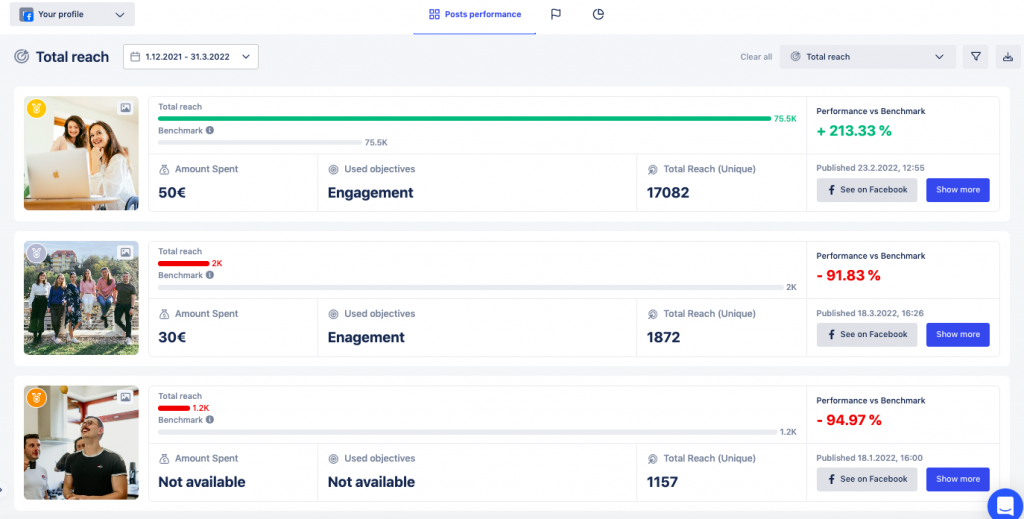
The main metrics you should be paying attention to are:
- Reach among your target audience
- Engagement Rate
- Reactions (Likes, comments, and shares)
- Clicks to website
However, you can and should measure other aspects, depending on your business goals.
Step 2: Choose the right channels for your strategy
Deciding which channels are best for your social presence can be tricky — you only have 24 hours a day, and you need to invest this time and energy wisely.
Weigh up the pros and cons of each social platform: reach, functionality, audience preference, and cost are key considerations when making this decision.
Research what has worked well for similar companies or organizations in the past. Pay attention to the analytics to demonstrate which platforms should be up for a task for reaching your particular marketing goals.
In this step, you also need to ensure that you don’t spread yourself too thin – pick social platforms that you already use and are confident in utilizing or providing the highest engagement levels.
Again, this is where you put your personal preferences aside and focus on the data. Also, you should match it with your resources. This means that if you want to run marketing campaigns on, say, five new social media platforms, but your social team consists of only three people, this task might be unmanageable.
Step 3: Decide what to include in your social media calendar
Content calendar inputs for your posting strategy can be bottomless. The most important aspect is to find balance between what your audience wants to see and what you want to promote. Then, your social media content calendar will act as a roadmap to plan and schedule your posts in advance.
You can start from one single document and build a whole suite of systems or sheets (read on for a solution for that), or end up using social media calendar tools to help you with this task.
Below, you’ll find a few ideas for elements of your social content calendars:
- Social media platform (which publishing platform are you posting it on?)
- Social media account (what is the URL of the profile?)
- Goal of the post (what do you want to achieve?)
- Type of post (is it a photo, video, or link post?)
- Time & date of the post (when should it be published?)
- Message/copy (what will be in the description of the post? This might include also video titles or alt attributes for, e.g., Instagram)
- Images/video (link to resources)
- Hashtag & mentions (what are the profile differentiators? List specific elements that have to be added to each post if it goes to multiple platforms)
- Notes (is there anything else that has to be defined? For example, for a post referring to specific weather conditions, you might want to add a note “double-check the weather on posting day”)
- Status (is it approved, submitted, scheduled, posted, or removed? Adjust as needed)
- Call-to-action (what do you want your audience to do after seeing your post?)
- Links (where should your audience be redirected?)
- Paid/organic post (is it going to be accompanied by a paid campaign to boost performance?)
Depending on your goals, there may be other inputs that are useful for you, such as influencer links, or UTMs/link tracking codes.
Step 4: Collaborate with your team
If you’re a lone social media marketer, then you might be able to manage the content on your own, at least to some extent. But if you’re part of a team or an agency managing multiple social media accounts, it can become more complex.
That’s why you need to work on team collaboration requirements and rules within your social media calendar. These would apply to both your internal processes and external approval rounds with your client.
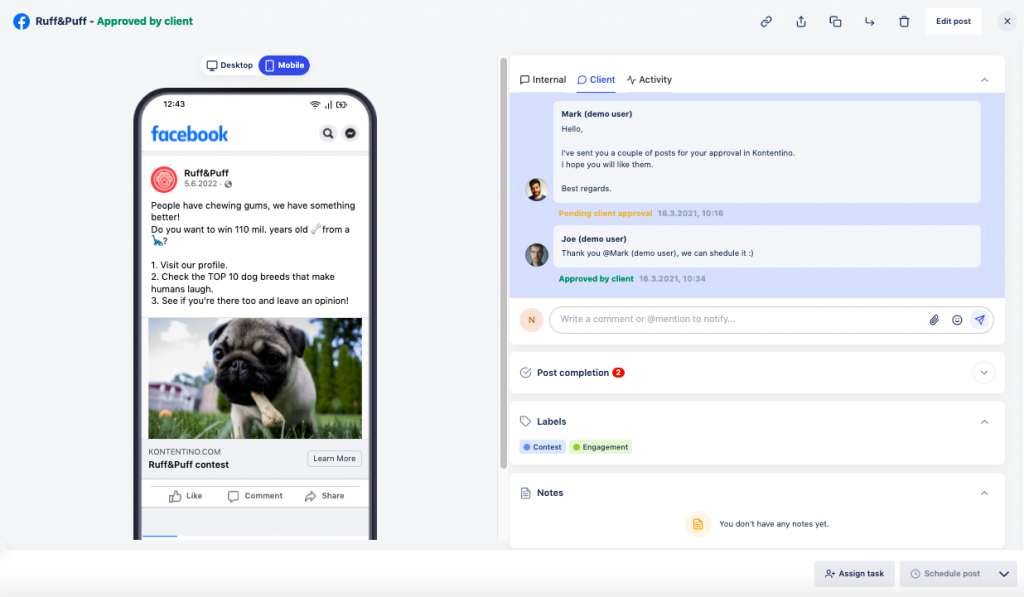
Everyone should have visibility over:
- what’s being published
- who’s responsible for each task
- which content requires approval
This is especially critical for social media managers who work remotely or manage multiple accounts. Get all of your team members on the same page in terms of content ideas and communicate clearly what the expectations or deadlines are for each task.
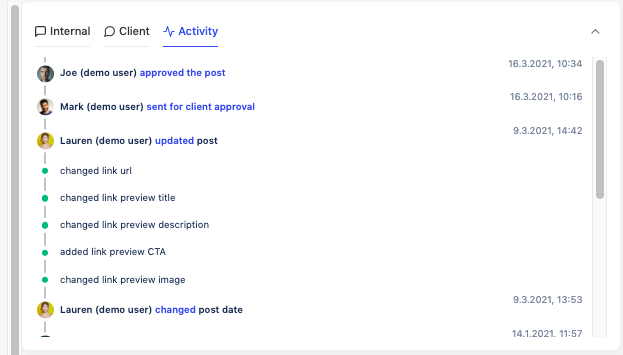
You can introduce numerous rules and processes that are specific to your team. It’s also key to be flexible and confirm that everyone understands the purpose of each process so they can adapt quickly if needed. It’s better to start slowly and increase the complexity of your processes step by step.
Step 5: Organize resources
Evaluate the resources and assets you already have – many elements of your social media content calendar may simply wait to be used or repurposed.
Organize all these elements into a library of resources that you can easily access when needed.
Start organizing your assets by gathering elements such as:
- social media image sizes cheat sheet
- basic image assets in various forms (e.g., templates, vectors, and graphics)
- logos in many color schemes and resolutions
- brand color palette
- brand guidelines
- typeface elements (your brand fonts + publicly available fonts that are allowed to be used as their replacements)
- repository of originally published social media posts and graphics
- archive of social media reports with key takeaways and posting frequency highlighted
While this is just a starting point, you can get creative to find other elements that may be useful.
Step 6: Analyze and optimize
Always track the performance of your social media marketing efforts to optimize your social media calendars and increase ROI.
Use social media analytics tools to produce automated reports and insights that inform your decisions. These will show you which content works better with your audience and offers more value.
Analyzing performance can help you adjust the components of your social media calendar, such as the types of content you produce, the timing and frequency of your posts, or the influencers you decide to work with.
If you need some kind of benchmark to compare against, a span of three months between analyzing and optimizing should be enough here.
This means that every three months:
- you look at the previous quarter’s results,
- analyze results,
- draw conclusions,
- implement them in the upcoming quarter.
Rinse and repeat.
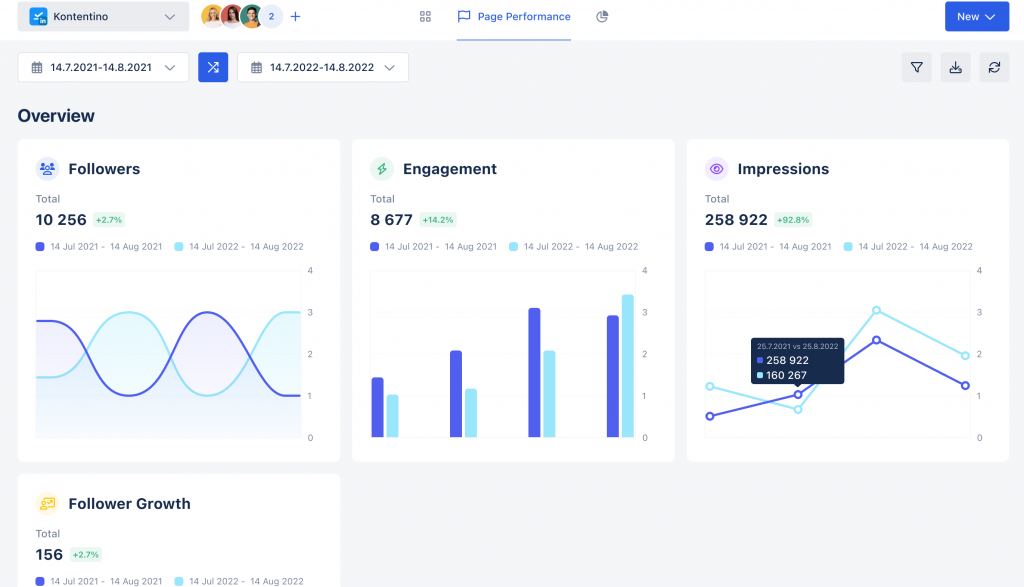
If you notice some post ideas particularly resonate with your audience or if there are relevant content trends to hop on right away, tweak your social calendar as you go without waiting for the next “evaluation period”.
The sooner you test your ideas, the sooner you get to see the results (and beat your competitors).
Free social media content calendar template
We’ve created a special social media content calendar template for social media teams to follow, adjust, and use in their own social media content creation process.
[/just_download]
Social media content calendar apps
1. Kontentino
Looking for the best social media calendar for a digital agency? Look no further.
Kontentino isn’t just a social media content calendar template. It’s way more than that.
With Kontentino, social media marketers can bring social media content from concept to completion with ease. From finding inspiration, through creating content and optimizing it for different platforms, to receiving client approval, scheduling posts, and analyzing the results – all in a single intuitive dashboard that works wherever you are.
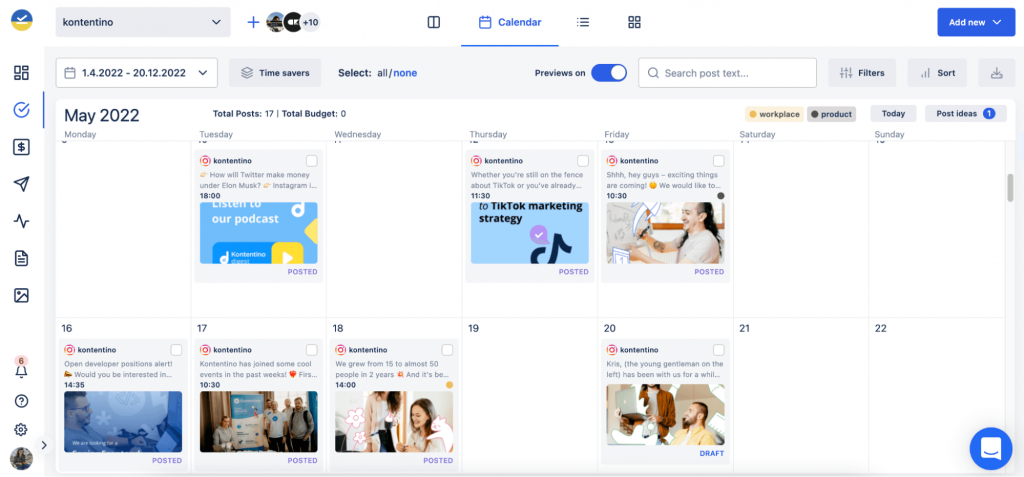
In a social media content calendar itself, you can:
- edit or reschedule your upcoming social media posts
- export your posts
- get approval on your social media campaign copy
- drag & drop posts between profiles and pages
- duplicate your posts or whole content plans
- add social media posts to a backlog or save them as drafts
Apart from creating and curating your social media content calendar, Kontentino can help you with:
- building a repository of copy and creatives
- creating a social media asset library handy for everyone
- setting up approval rules for internal and external use
- putting tags and labels for better navigation through your strategy
- conducting basic graphic edits
- generating post requirement checklists and notes for your team
- keeping an eye on multiple social media channels under one roof
Think of Kontentino as your very own marketing wizard! 🪄
This powerful social media management tool lets you cast a content spell to conjure up an amazing social media posting schedule that engages your audience. Create custom calendar templates, collaborate within marketing teams, and approve posts quickly, gain insights into performance, and more.
Start your free trial and build your posting calendar now.
2. Google Sheets
Google Sheets are free to use and always available in the cloud, so you and your team can access them anywhere, anytime. If you’ve ever used spreadsheets, a social media content calendar created in Sheets should be intuitive to set up, use, and share with your team.

Google Sheets lack a couple of features that make social media publishing a bit easier, though. For example, you don’t have the ability to quickly drag & drop posts from one day to another without copying-pasting your data.
Sending tasks for approval can only be done via comments with tagging, which can get a bit messy when it comes to a posting schedule for multiple social posts or social channels. Moreover, you can’t publish posts directly to your social media profiles, so it’s not a social media tool per se.
Google Sheets is a cost-efficient way to plan content on social media, especially if you’re just starting out in the game, but might not cut it if your social media management process has become complex.
3. Trello
Trello is one of the most popular project management tools out there, and it’s widely used for creating social media content calendars as well. However, Trello is not necessarily a true social media calendar tool.
It’s more of a board-based system with columns and cards that can be dragged around the board in whatever way you see fit. For social media content creation, it can be helpful, but it doesn’t have all of the features provided by social media calendar tools.
Trello doesn’t offer pre-set or built-in social templates, so it’s up to you to create the social media calendar template and layout. This makes Trello more versatile in terms of creating custom boards with lists, labels, and task management tools, but not merging it with social media platforms or direct planning for future posts.
Social media team layout for publishing
Even the most effective social media calendar can’t schedule and manage itself. To have a great social media presence, you need to build a well-structured team and efficient workflows.
The composition and workflow of your team can vary based on whether you use tools like Kontentino. Below, we outline the necessary positions for a social media team with and without the use of social media management platforms – so that you can clearly see the difference.
Team composition without Kontentino
If your team does not use any social media management tools, you will need a more extensive team to handle various aspects of social media marketing. Here are the key positions required:
- Social Media Manager: Oversees the social media strategy, maintains a consistent posting schedule, and monitors social media performance with a helicopter view.
- Content Creator: Produces relevant content, including text, images, and videos for multiple social media platforms.
- Graphic Designer: Creates visual content and creative assets for social media posts.
- Copywriter: Writes engaging and effective social media posts and captions.
- Community Manager: Engages with the audience, responds to comments, and manages interactions on social media networks.
- Analyst: Conducts social media audits, tracks social media performance, and provides social media post insights for strategy adjustments or social media marketing campaigns.
- Scheduler: Manually schedules posts across different social media platforms and maintains your own social media calendar.
Team composition with Kontentino
Using a social media management platform like Kontentino can make your social media efforts for successful – as it reduces the number of team members needed and helps your efficiency get on a brand new level. Here are the key positions required:
- Social Media Manager: Oversees the social media strategy and manages the team within Kontentino.
- Content Creator: Produces content directly in Kontentino, utilizing its social media calendar templates.
- Community Manager: Engages with the audience using Kontentino’s interactive dashboard.
- Analyst: Uses Kontentino’s analytics to track social media performance and generate reports.
As you can see, some of the job roles completely vanish in this setup, and the others are adjusted to the new requirements. For example, now content creator is responsible for social media planning directly in Kontentino – instead of collaborating with a scheduler.
Exemplary workflow without Kontentino
- Content Planning: The Social Media Manager, Content Creator, and Graphic Designer meet regularly to plan content for upcoming social media posts. They use a social media calendar template in tools like Google Calendar to plan the posting schedule. This step involves extensive discussions to match the content with the social media marketing strategy and social media marketing goals.
- Content Creation: The Content Creator drafts initial content ideas, including text and concepts for visuals. The Copywriter refines the text to make it engaging and aligned with the brand voice. The Graphic Designer works on creating visual content that matches the planned themes. This stage involves multiple iterations and feedback loops.
- Approval Process: All created content is compiled and presented to the Social Media Manager for approval. This step often requires several rounds of revisions. The Social Media Manager checks all the key details for each post to align with the social media strategy.
- Scheduling: The Scheduler manually uploads and schedules posts across multiple social media platforms. This involves entering each post’s details into the respective platforms, maintaining the posting schedule.
- Engagement: The Community Manager monitors interactions on various social media networks. They respond to comments and messages, engaging with the audience. This role is critical for maintaining a strong social media presence.
- Analysis: The Analyst conducts regular social media audits and tracks performance metrics using separate analytics tools. This involves gathering data on post performance and audience engagement. The Analyst compiles reports and shares them with the team to inform ongoing social media efforts.
Depending on the project, this workflow can also include content approval. This can be taken care of by content creators or social media managers, but might also involve another person in the process – such as an account manager.
Exemplary workflow with Kontentino
Since Kontentino reduces friction in planning, there are fewer steps in the process and they can be considered more “agile” – as you have more flexibility in tailoring them for your social media scheduling needs. Below, you’ll find the structure you can adjust to your own marketing calendar:
- Content Planning and Creation: The Social Media Manager and Content Creator use Kontentino’s social media content planner to outline the social media strategy and create content. The centralized approach keeps the marketing team on the same page and reduces the time spent on planning and content creation.
- Approval and Scheduling: The Social Media Manager uses Kontentino’s built-in approval workflow to review and approve posts within the platform. Once approved, the Social Media Manager can schedule posts across various social media platforms using Kontentino’s social media scheduling tool. The automated process maintains a consistent posting schedule.
- Engagement: The Community Manager uses Kontentino’s interactive dashboard to engage with the audience in real-time. The centralized approach allows efficient management of interactions across multiple channels.
- Analysis: The Analyst utilizes Kontentino’s comprehensive analytics to track social media performance and generate insightful reports. Kontentino’s integrated analytics provide a clear overview of key metrics, simplifying the process of measuring social media success and informing future strategies.
Social media content calendar ideas and examples
To get you started on the right foot with your publishing schedule, here are some examples of social media calendars that could help you plan your campaigns in a more organized fashion:
- In this content calendar shared by Semrush, you can access a very simple social media content calendar template that allows you to plan posts for all major social media channels.
- A short and customizable social media content plan example with a free template can also be found on Backlinko.
- Social Media Examiner shares a free template of social media calendar that is ready for you to be taken and expanded further (since, for now, it only includes basic fields).
- You can find a couple of Google Sheets template examples and inspirations for your social media calendar on Smartsheet.
- If you’re looking for a basic social media content calendar you can extend with your ideas, here’s a social media calendar template from Hootsuite.
Quick fixes for your social media calendar
Who said that all changes have to take ages? Read a few things you can do with your social media calendar right now to make it more efficient.
Stop creating new content daily – repurpose what you have
Constantly creating new content is exhausting and unnecessary. Use your existing content to create different formats. Turn blog posts into infographics, videos, or carousel posts.
For example, transform a detailed article into a series of Instagram posts or a quick TikTok video. This saves time and reaches various audience segments.
Ignoring trends is not a good idea – share posts to Stories
Neglecting Stories means missing out on engagement, big time. Always share your posts to Stories on Instagram and Facebook for better reach. Add interactive elements like polls, questions, and stickers – all these options are there for you, natively. For example, promote a new product with a fun quiz or highlight a blog post with a swipe-up link. It takes only a few seconds – but can bring you higher reach and engagement on the spot.
Conduct mini social media audits
Assuming your strategy is perfect? Think again. Very often, social media managers keep waiting with a proper audit for way too long – while they can conduct a mini social media audit regularly. Check recent posts, engagement rates, and follower growth.
Use tools like Kontentino to analyze performance. Identify what’s working and adjust your strategy for better results. Sometimes, it can be a small tweak only – and that’s more than enough!
Don’t do it all yourself – leverage user-generated content
Doing it all yourself is unsustainable. Encourage your audience to create content about your brand. Share user-generated content on your channels, or run a hashtag campaign or a photo contest. While it boosts engagement, it also provides authentic content that your audience might be seeking. It also builds a community feeling among your followers and encourages them to share more content, too.
Interact with your audience
Neglecting your audience can hurt your brand, but . Make it a habit to engage with your audience daily. Respond to comments and messages promptly. Like and share user content that mentions your brand. For instance, thank users who share your posts or ask questions to spark conversations. Keep the conversation loop to the point when it dries out or doesn’t feel any natural to keep going.
Post and forget? No way! Adjust content
Posting and forgetting is ineffective. Analyze your social media performance regularly. Use insights from Facebook, Instagram, and other platforms to see what works. Adjust your content strategy based on this data. For example, if videos get more engagement, create more video content.
Make the most of evergreen content
Evergreen content remains relevant over time. Repost timeless articles, tips, or tutorials. For instance, share a seasonal guide every year or repost an always-relevant how-to video. It helps you maintain a consistent posting schedule without the need for constant new content creation – so that you always have something in your social media calendar.
Plain text posts can get overlooked – add visuals to every post
Always include visuals like images, GIFs, or videos. Posts with visuals catch the eye and draw more engagement. Visual content stands out in crowded feeds and can convey your message more effectively.
Use tools like Canva to quickly create eye-catching graphics. Visuals can make even simple messages more appealing. For example, pair a motivational quote with a vibrant background image for better engagement. It’s an easy method to boost likes, shares, and overall interaction.
Long URLs look messy – shorten and track them
Use link shorteners like Bitly to create clean, trackable links. Short links look professional and are easier to share, but they also give you another benefit – you can personalize them, at least partially. Tracking links helps you understand which posts drive traffic as you’re getting another analytical touchpoint here. For example, turn a lengthy blog post URL into a concise, branded link to monitor clicks and engagement and measure the effectiveness of your campaigns. Keep your social media posts tidy and informative.
Create a hashtag bank
Make a database with groups of relevant hashtags. Organized hashtags save time when posting. Group hashtags by themes, campaigns, clients, or seasons for easy access – and rotate them for different posts. For instance, have a set for industry news and another for product launches. You can keep them in a database, behind some keyboard shortcuts, or… transfer them to tools like Kontentino to always have them handy with you. This strategy keeps your content discoverable, as you can tailor hashtags to maximize reach and engagement.
Want more interaction? Ask questions in social media posts
Sometimes, the easiest methods to boost interaction are just around the corner. In this case, it’s about the elements you use in your social media post. Posts with questions invite engagement. Questions encourage followers to share their thoughts and experiences. Ask your followers for opinions or experiences. For example, a fitness brand could ask, “What’s your favorite workout routine?” This encourages comments and boosts post visibility, and interactive posts can build community and increase engagement for years to come.
Relying on a single platform limits your reach – diversify your presence
Kontentino makes this step so easy and accessible! Expand even a single post idea to other social networks. Different platforms have unique user bases, so diversifying reduces reliance on one channel. For example, if you’re only on Instagram, start posting on LinkedIn or Twitter. If you focused on Facebook posts, try a social media channel like TikTok. Each platform has unique audiences and benefits. Engage with users on multiple platforms for maximum impact.
Posting at random times can miss your audience – optimize your posting times
Use analytics tools to find when your followers are most active. Peak times vary by audience and platform, and scheduling posts for peak times maximizes engagement.
For instance, post in the evening if your audience engages most after work. Optimize your posting schedule to connect with your audience effectively and catch them always when they are online.
Start creating your social media calendar now!
Creating a social media content calendar is one thing, but actually filling it in and keeping the momentum is a different story. You need to remember many elements, track and monitor your social media campaigns’ performance, and, on top of that, focus on content creation with a specific objective in mind.
But if you manage to stay consistent with your social media strategy and stick to the content plan, you can reap all of the benefits that come with having a social media calendar.
FAQ
What should a social media content calendar include?
A social media content calendar should include scheduled posts, social media strategy, target audience, upcoming posts, social media calendar templates, and a consistent posting schedule. It ensures your marketing team can plan and create content effectively.
What is the difference between a social media calendar and a content calendar?
A social media calendar focuses on scheduling posts for social media networks like Facebook and Instagram, while a content calendar includes broader content planning across all marketing channels, ensuring timely and evergreen content.
How do I create a content calendar?
To create a content calendar, use a social media content planner or Google Calendar. Include your social media strategy, target audience, and posting schedule. Plan upcoming posts and ensure your marketing team can post consistently.
How do I plan monthly social media content?
Plan monthly social media content by using a social media calendar. Outline your social media strategy, schedule posts, and identify upcoming posts. Utilize social media calendar templates and a social media manager to post consistently across popular social media platforms.





